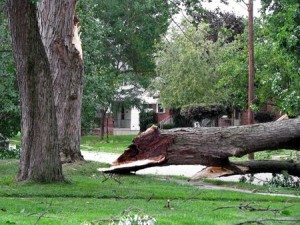
When there are big storms, there is always a lot of wreckage. Houses can be torn apart, cars moved and sometimes thrown from their original location, and trees fall onto properties.
When Hurricane Sandy came through, it knocked over 8,497 trees in New York City alone. However, a storm isn’t always required for a tree to fall. Some also stay firmly planted in the ground.
So what gives?
The fact is, all trees have the potential to get uprooted when faced with some amount of force from the elements. This is because of what is known as ‘windthrow” which can uproot a tree. In a sense, the trunk acts like a lever so that the force that is applied to the tree increases with the height, making taller trees more susceptible.
Typically, the roots of trees can spread out 1-2.5 times the radius of the branches, and unfortunately many urban settings do not allow for that much development. Many times the roots are crushed, torn or stunted in growth. This can cause decay and less of a “grip” on the earth.
The more a tree is able to sway and how much movement the tree has will also play into its possible fate of being uprooted. This causes them to “wiggle” out of the ground and eventually tip over. Strong winds cause trees to uproot the most.
Often times it is because of injury or poor growth that the tree becomes susceptible to falling over, especially during bad storms. Some however have strong bases with roots that were allowed to branch out and give greater support to the tree.
If you’ve had a tree fall near you and you need assistance, call Big Foot Tree Service and we can help you clean it up with our 24/7 emergency storm clean up!









Recent Comments